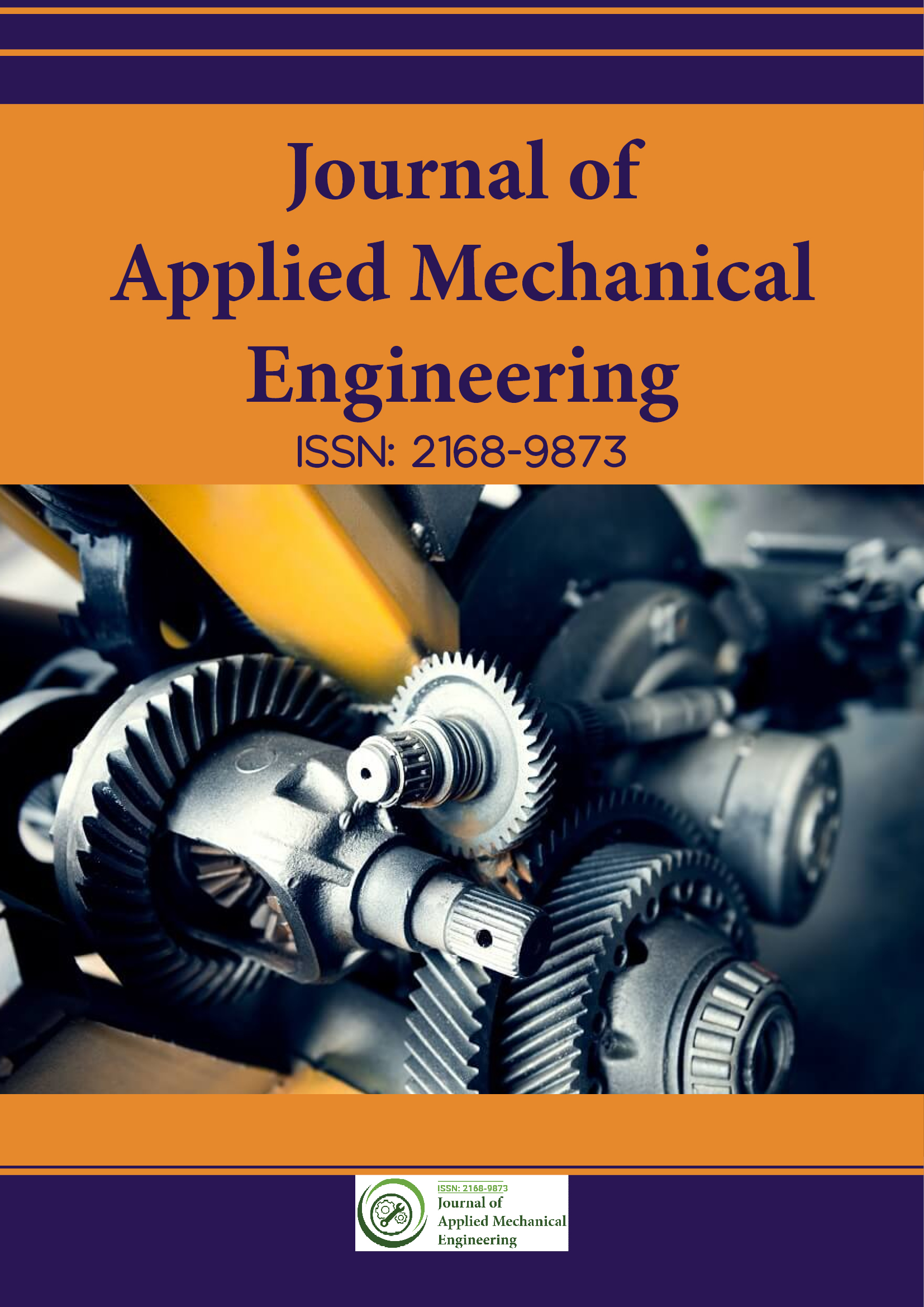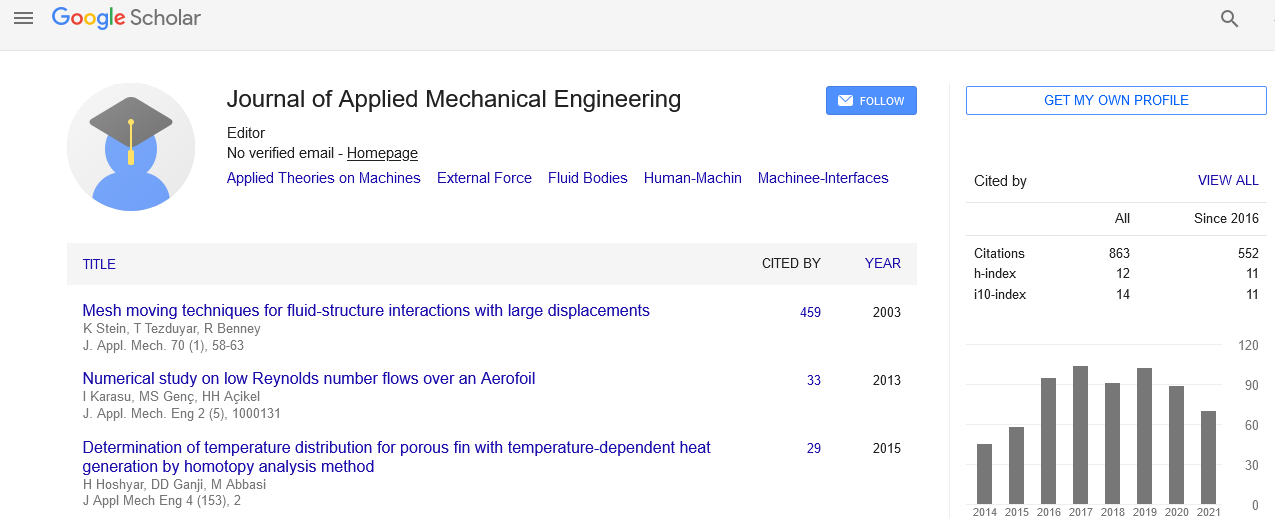Indexed In
- Genamics JournalSeek
- JournalTOCs
- CiteFactor
- RefSeek
- Hamdard University
- EBSCO A-Z
- OCLC- WorldCat
- Publons
- Google Scholar
Useful Links
Share This Page
Journal Flyer

Open Access Journals
- Agri and Aquaculture
- Biochemistry
- Bioinformatics & Systems Biology
- Business & Management
- Chemistry
- Clinical Sciences
- Engineering
- Food & Nutrition
- General Science
- Genetics & Molecular Biology
- Immunology & Microbiology
- Medical Sciences
- Neuroscience & Psychology
- Nursing & Health Care
- Pharmaceutical Sciences
Perspective - (2025) Volume 14, Issue 1
Haptics in Mechanical Engineering: Revolutionizing Touch Sensation and Interaction
Karl Sanchez*Received: 14-Nov-2023, Manuscript No. JAME-23-23907; Editor assigned: 17-Nov-2023, Pre QC No. JAME-23-23907; Reviewed: 01-Dec-2023, QC No. JAME-23-23907; Revised: 09-Jan-2025, Manuscript No. JAME-23-23907; Published: 16-Jan-2025, DOI: 10.35248/2168-9873.25.14.525
Description
Haptics, the science of touch and tactile feedback, has emerged as a transformative field in mechanical engineering, reshaping the way we interact with technology and enhancing the sensory experience of users. Grounded in the principle of simulating the sense of touch through force, vibration, and motion feedback, haptics has found widespread applications in fields ranging from virtual reality to robotics. This article explores the fundamental principles, applications, challenges and future trends of haptics in the realm of mechanical engineering.
Haptics encompasses the study of touch, force, and tactile sensation, aiming to recreate the sense of touch in humanmachine interactions. It involves the use of technology to simulate the feeling of interacting with physical objects, providing users with a more immersive and realistic experience. Haptic feedback is achieved through the use of actuators, sensors and control algorithms that enable the generation of forces, vibrations and motions.
Actuators in haptics
Actuators are crucial components in haptic systems, responsible for generating the physical sensations that users can feel. Common types of actuators include Linear Resonant Actuators (LRAs) and Eccentric Rotating Mass (ERM) motors, which produce vibrations and piezoelectric actuators, which generate precise movements. These actuators work in harmony to recreate a wide range of tactile sensations.
Sensors and feedback
Haptic systems utilize sensors to gather information about the user's interaction with a device or environment. Force sensors, accelerometers and touch sensors are employed to capture the user's input. The collected data is then processed by control algorithms and appropriate feedback is generated to simulate the tactile experience.
Applications of haptics in mechanical engineering
Virtual Reality (VR) and Augmented Reality (AR): Haptic plays a vital role in VR and AR by enhancing the immersive experience. In virtual environments, haptic feedback simulates the sensation of interacting with virtual objects, adding a layer of realism to simulations, training programs and gaming applications. Users can feel the resistance, texture and impact associated with virtual objects.
Medical simulation: In medical training, haptic enables the creation of realistic surgical simulations. Surgeons can practice procedures in a virtual environment where haptic feedback mimics the resistance and sensations of real tissues. This application allows for skill development and training without the need for live patients.
Gaming and entertainment: Haptic feedback has become a standard feature in gaming controllers, providing players with a more engaging and sensory-rich experience. The vibrations and forces generated by haptic actuators simulate in-game events, such as collisions, impacts and environmental interactions, enhancing gameplay immersion.
Remote operations and telepresence: In remote operations and telepresence applications, haptic allows users to feel and manipulate objects at a distance. This is particularly valuable in scenarios such as robotic surgery, where surgeons can remotely control robotic arms with a sense of touch feedback, overcoming the limitations of physical separation.
Challenges and considerations
Achieving realistic and precise haptic feedback poses technical challenges. Mimicking the diverse range of sensations experienced in the real world requires sophisticated actuators, sensors and control algorithms capable of delivering nuanced feedback. Haptic systems can be energy-intensive, especially in applications requiring high-frequency vibrations or complex force simulations. Balancing the need for immersive feedback with energy efficiency is a consideration in designing haptic solutions. Integrating haptic feedback seamlessly with other technologies, such as visual and auditory elements in VR, poses challenges in terms of synchronization and coherence. Ensuring a unified and immersive experience requires careful coordination of multiple sensory inputs. As haptic technology expands into wearable devices, miniaturization becomes crucial. An important area of attention for academics and engineers is designing small and light haptic actuators for wearables without compromising functionality or efficiency.
Conclusion
Haptics has evolved from a niche field to a transformative force in mechanical engineering, revolutionizing the way we interact with technology and enhancing sensory experiences across various applications. From the realistic touch sensations in virtual environments to the precise feedback in medical simulations, haptics is at the forefront of innovation. As technology continues to advance, the integration of haptic feedback with other emerging technologies, such as soft robotics and augmented reality, promises even more immersive and intuitive interactions. The challenges of complexity, energy efficiency and seamless integration are being addressed through ongoing research and development. The future of haptics holds exciting possibilities, where touch becomes a more integral and natural part of our interaction with the digital and physical worlds. In the dynamic landscape of mechanical engineering, haptics stands as a testament to the capacity of technology to enhance and enrich the human experience.
Citation: Sanchez K (2025) Haptics in Mechanical Engineering: Revolutionizing Touch Sensation and Interaction. J Appl Mech Eng. 14:525.
Copyright: © 2025 Sanchez K. This is an open-access article distributed under the terms of the Creative Commons Attribution License, which permits unrestricted use, distribution, and reproduction in any medium, provided the original author and source are credited.

